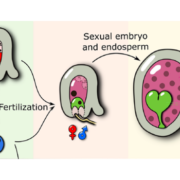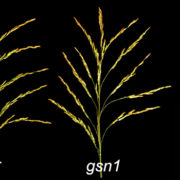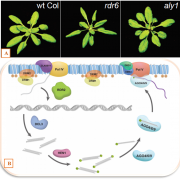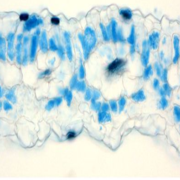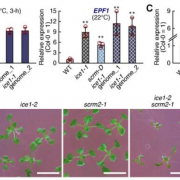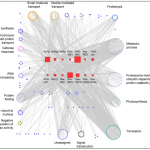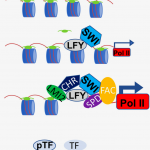A complementary mechanism to the microRNA-mediated control of leaf size (Plant Physiol)
 Plants form leaves with highly reproducible sizes and shapes by employing a conserved set of developmental regulators. During early leaf growth, a zone of high cell proliferation is formed towards the proximal end of the lamina. Proliferating cells progressively exit this zone and enter the distal half of the lamina where cell expansion and differentiation take place. GROWTH REGULATING FACTORs (GRFs) are key determinants of leaf size by promoting cell division in the proliferation zone. A non-coding microRNA, miR396 post-transcriptionally suppresses GRFs in the expansion zone and confines their activity to the proliferation zone. In their recent study, Beltramino et al. identified a set of GRFs present in virtually all members of Brassicaceae that are not targeted by miR396. Although they were known to perform functions in leaf development similar to the miR396-controlled GRFs, how their expression is spatially regulated in the leaf lamina has been unknown. The authors found that unlike miR396-regulated GRFs that undergo post-transcriptional regulation, the expression of GRF5, which is not targeted by miR396, is spatially constrained primarily through direct transcriptional suppression by AUXIN RESPONSE FACTOR2 (ARF2). In the absence of ARF2, the plant loses the control over the expression of GRF5, causing greater cell number and leaf size. Manipulating miR396-targeted GRFs together with the ARF2-GRF5 module resulted in additive changes on leaf size, hinting at a possibility of using this combination for agronomically desirable leaf traits. (Summary by Yadukrishnan Premachandran @yadukrishprem) Plant Physiol. 10.1093/plphys/kiab014
Plants form leaves with highly reproducible sizes and shapes by employing a conserved set of developmental regulators. During early leaf growth, a zone of high cell proliferation is formed towards the proximal end of the lamina. Proliferating cells progressively exit this zone and enter the distal half of the lamina where cell expansion and differentiation take place. GROWTH REGULATING FACTORs (GRFs) are key determinants of leaf size by promoting cell division in the proliferation zone. A non-coding microRNA, miR396 post-transcriptionally suppresses GRFs in the expansion zone and confines their activity to the proliferation zone. In their recent study, Beltramino et al. identified a set of GRFs present in virtually all members of Brassicaceae that are not targeted by miR396. Although they were known to perform functions in leaf development similar to the miR396-controlled GRFs, how their expression is spatially regulated in the leaf lamina has been unknown. The authors found that unlike miR396-regulated GRFs that undergo post-transcriptional regulation, the expression of GRF5, which is not targeted by miR396, is spatially constrained primarily through direct transcriptional suppression by AUXIN RESPONSE FACTOR2 (ARF2). In the absence of ARF2, the plant loses the control over the expression of GRF5, causing greater cell number and leaf size. Manipulating miR396-targeted GRFs together with the ARF2-GRF5 module resulted in additive changes on leaf size, hinting at a possibility of using this combination for agronomically desirable leaf traits. (Summary by Yadukrishnan Premachandran @yadukrishprem) Plant Physiol. 10.1093/plphys/kiab014


